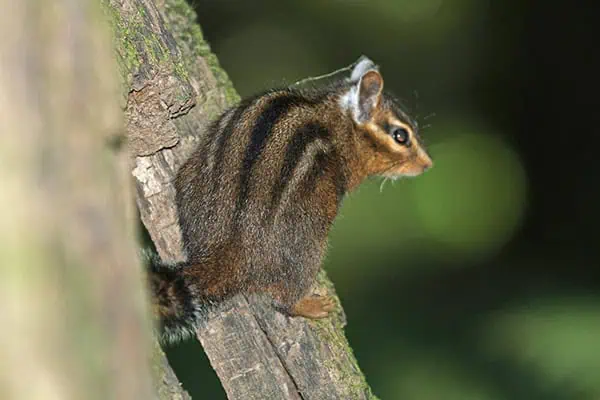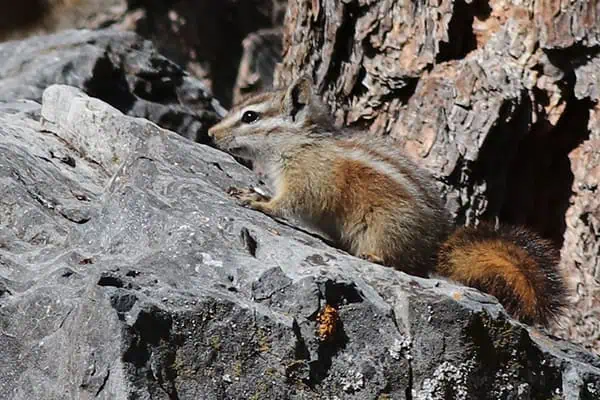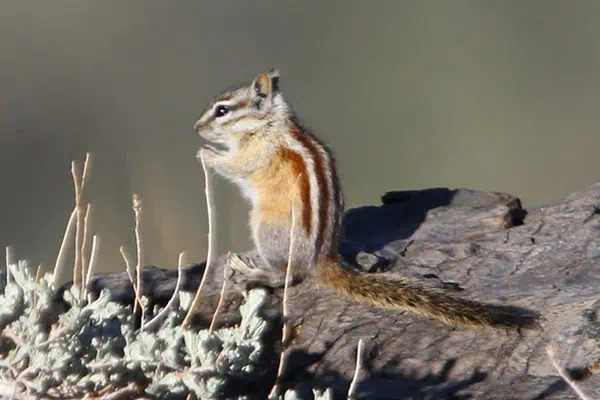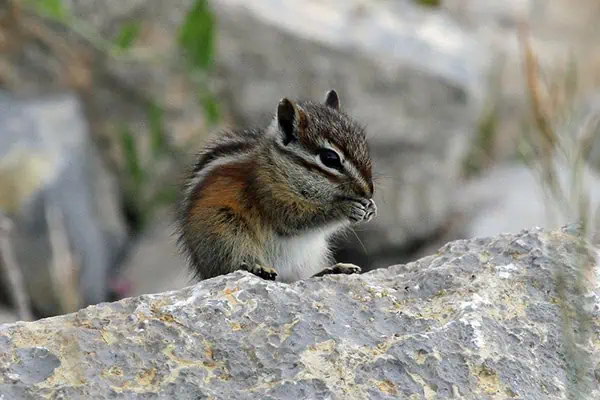Chipmunks are small, striped members of the squirrel family found throughout North America. While they look similar at first glance, there are 22 different species living across the United States, Canada, and Mexico. In this list we’ll go through each type of chipmunk and where you can find them.
22 types of chipmunks in North America
1. Eastern chipmunk

Scientific name: Tamias striatus
The eastern chipmunk is the only species found across the eastern United States and parts of southern Canada. It is easy to recognize by its reddish-brown fur, white belly, and five dark stripes running down its back with lighter bands in between. Adults are small, usually around 9 to 12 inches in total length including the tail, and they often live in wooded areas, parks, and suburban yards where trees and shrubs provide plenty of cover.
These chipmunks are active during the day and spend much of their time gathering seeds, acorns, and berries, which they store in underground burrows for winter. They also eat insects and small invertebrates when available. In colder regions, eastern chipmunks enter a long period of dormancy through the winter months but will wake occasionally to snack on the food they stored earlier in the year.
2. Least chipmunk

Scientific name: Neotamias minimus
The least chipmunk is the smallest of all chipmunk species and has the widest range across North America. It resembles the eastern chipmunk but has a slimmer body, paler brown or gray fur, and narrower stripes. It is found across much of Canada, the northern United States, and into the Rocky Mountains.
This chipmunk thrives in open woodlands, brushy fields, and even alpine meadows where it gathers seeds, nuts, and berries. It often climbs low shrubs to reach food and is quick to retreat to burrows or rock crevices when alarmed. During colder months it enters a state of torpor, waking on warmer days to feed on the caches it prepared earlier in the season.
3. Colorado chipmunk

Scientific name: Neotamias quadrivittatus
The Colorado chipmunk lives in the central and southern Rocky Mountains, with its range mainly in Colorado and parts of New Mexico and Utah. It has a noticeably larger body than many western species and features bold white stripes on a warm brown coat, giving it a sharp, contrasting pattern. These markings, along with its longer tail, make it easy to distinguish when seen on mountain trails and rocky slopes.
This species favors forests of pine and aspen but is also common around rocky outcrops and brushy hillsides. It feeds on pine seeds, fruits, berries, and insects, often storing extra food in crevices or underground chambers. Colorado chipmunks are active during the day and spend much of the warmer months gathering food in preparation for winter inactivity.
4. Uinta chipmunk

Scientific name: Neotamias umbrinus
The Uinta chipmunk is native to the central Rocky Mountains, especially in Utah, western Wyoming, and parts of Colorado. It has a rich reddish-brown back, strong black and white striping, and a noticeably bushy tail. This species often lives at higher elevations where conifer forests meet open meadows and rocky slopes.
Its diet includes a wide mix of pine nuts, berries, fungi, and insects. The Uinta chipmunk is quick and agile, moving between rocks and logs as it forages, and it uses hollow logs or natural cavities for food storage. As winter approaches it becomes less active, relying on the stores it collected throughout the warm season.
5. Townsend’s chipmunk

Scientific name: Neotamias townsendii
Townsend’s chipmunk is the largest chipmunk species in North America and is found in the coastal forests of Washington, Oregon, and southwestern British Columbia. It has a darker coat than many other species, with wide black stripes separated by pale bands and a thick, dark tail. These chipmunks are often seen darting across fallen logs in dense, moist forests.
They feed on a diet of seeds, mushrooms, berries, and occasionally small insects. In autumn, Townsend’s chipmunks are especially busy gathering food, storing it under stumps or in hollow logs to last through the cold months when they become far less active.
6. Cliff chipmunk

Scientific name: Neotamias dorsalis
The cliff chipmunk lives in the arid canyon regions of the southwestern United States, particularly in Arizona, Utah, Nevada, and New Mexico. It has a slim body with grayish-brown fur and thin stripes, well suited for blending into rocky cliffs and desert scrub. Unlike the forest-dwelling species, it is commonly seen scrambling up steep rock faces and along ledges.
This species survives on seeds, cactus fruits, berries, and insects, making use of whatever food sources are available in its dry environment. It shelters in cracks or small caves in the rock, where it also hides the food it collects to see it through the leaner times of year.
7. Hopi chipmunk

Scientific name: Neotamias rufus
The Hopi chipmunk is native to the Four Corners region of the southwestern United States, occurring in parts of Arizona, Utah, Colorado, and New Mexico. It has a light, sandy-brown coat with narrow stripes and a smaller, slender build that helps it move easily over rocks and dry ground. Its coloring makes it difficult to spot against the red soil and stone of its desert habitat.
Hopi chipmunks feed on seeds, nuts, and desert fruits, storing what they collect in shallow burrows or crevices. They are active during the cooler hours of the day and are cautious, quickly retreating to safety at any sign of danger.
8. Red-tailed chipmunk

Scientific name: Neotamias ruficaudus
The red-tailed chipmunk lives in the northern Rocky Mountains, including areas of Idaho, Montana, and southeastern British Columbia. It is named for the reddish tinge on its tail, which stands out against its gray-brown body and clearly defined stripes. This species is often found in coniferous forests and on the edges of clearings and talus slopes.
Its diet includes seeds, berries, and insects, and it often climbs low branches to reach food sources. Red-tailed chipmunks make use of logs, hollow stumps, and natural holes in the ground to hide the food they collect during the warmer months.
9. Yellow-pine chipmunk

Scientific name: Neotamias amoenus
The yellow-pine chipmunk is widespread in the forests of the western United States and parts of southern Canada. It has a warm brown back, distinct dark stripes, and a pale underside. This species is commonly seen in pine and fir woodlands, especially where open clearings provide sunny areas for foraging.
It feeds on a variety of pine seeds, berries, fungi, and small invertebrates. Yellow-pine chipmunks are very active during daylight, spending much of the summer and fall collecting food and storing it in caches beneath logs or in shallow burrows.
10. Lodgepole chipmunk

Scientific name: Neotamias speciosus
The lodgepole chipmunk inhabits the Sierra Nevada and nearby mountain ranges of California and western Nevada. It has a rich chestnut-colored coat with dark stripes, a lighter belly, and a long, fluffy tail. These chipmunks are often seen at mid to high elevations in conifer forests, especially around lodgepole pines that give the species its name.
Its food sources include seeds, cones, berries, and insects, which it collects and hides for later use. During colder months it remains in its burrow, waking occasionally to feed on the stored food that helps it survive the winter.
11. Long-eared chipmunk

Scientific name: Neotamias quadrimaculatus
The long-eared chipmunk is a high-elevation species found mainly in California’s Sierra Nevada. It has noticeably long ear tufts compared to other chipmunks, a reddish-brown coat, and bold black and white stripes down its back. This species prefers cool forests and subalpine meadows where it can find both cover and open areas to forage.
It has the typical chipmunk diet and makes good use of hollow logs and rock crevices for storing food. The long-eared chipmunk spends the warmer months gathering enough supplies to help it through the long, snowy winters of its mountain home.
12. Sonoma chipmunk

Scientific name: Neotamias sonomae
The Sonoma chipmunk is found in a limited part of coastal northern California, where it lives in oak woodlands, chaparral, and dense thickets. It has a dark brown coat, narrow pale stripes, and a smaller body size that helps it move quickly through thick vegetation.
This species feeds on acorns, seeds, and berries, caching what it collects in burrows or beneath logs. Sonoma chipmunks are alert and active during the day, and their quick, darting movements make them a challenge to spot for long in the brushy terrain they call home.
13. Allen’s chipmunk

Scientific name: Neotamias senex
Allen’s chipmunk is native to the forests of northern California, often living in mixed conifer and oak woodlands. It has a warm brown coat, faint striping compared to some species, and a bushy tail. This chipmunk is often found foraging on the ground among fallen branches and leaf litter.
Its diet consists of acorns, seeds, and berries, and it sometimes adds insects to the mix. Allen’s chipmunks build hidden food stores in natural cavities or underground to help them make it through the colder months when food becomes scarce.
14. Siskiyou chipmunk

Scientific name: Neotamias siskiyou
The Siskiyou chipmunk lives in a small area of southern Oregon and northern California, mostly in the Siskiyou Mountains. It has a gray-brown back, narrow pale stripes, and a relatively short tail. This species prefers dense forests and brushy slopes where it can move quickly between cover.
Siskiyou chipmunks eat seeds, nuts, and berries, often carrying their finds back to concealed caches. They are active during the day and remain close to cover, using fallen logs and rocks as safe pathways through their environment.
15. Palmer’s chipmunk

Scientific name: Neotamias palmeri
Palmer’s chipmunk is found only in the Spring Mountains of southern Nevada, making it one of the most range-restricted species. It has a warm brown coat with distinct dark stripes and a lightly colored belly. The isolated habitat and small population make this chipmunk unusual among its relatives.
It feeds on pine seeds, berries, and small fruits, collecting what it needs from the surrounding mountain vegetation. Palmer’s chipmunks build their caches in natural cavities and rocky areas, storing enough food to sustain them through the cold, dormant months of winter.
16. California chipmunk

Scientific name: Neotamias obscurus
The California chipmunk lives in southern California and just across the border into northern Baja California. It has a grayer coat than many other species, with dark stripes and a relatively slender build. It is most often found on dry, rocky hillsides and in coastal scrub habitats.
This chipmunk eats a variety of seeds, berries, and small fruits, using crevices and underground shelters to hide its collected food. It is active mostly in the morning and late afternoon, resting during the hottest part of the day in its shaded retreats.
17. Panamint chipmunk

Scientific name: Neotamias panamintinus
The Panamint chipmunk is a desert-dwelling species found in eastern California and parts of Nevada, especially in the Panamint Range. It has a tan to gray coat, clear stripes, and a slender frame adapted to the dry, rugged landscape. This chipmunk often lives in rocky canyons, cliffs, and scrub-covered slopes.
Its food sources include seeds, desert fruits, and the occasional insect. Panamint chipmunks store their food in cracks and small caves, which also serve as shelter from the intense desert heat and protection from predators.
18. Gray-collared chipmunk

Scientific name: Neotamias cinereicollis
The gray-collared chipmunk is found in the mountain forests of Arizona, New Mexico, and northern Mexico. It is named for the pale gray fur around its neck and shoulders, which stands out against its reddish-brown back and dark stripes. It tends to live in mixed pine and fir woodlands at moderate to high elevations.
This chipmunk feeds on pine seeds, acorns, berries, and insects, often climbing fallen logs or shrubs to search for food. It uses hollow logs, crevices, and underground tunnels as hiding places for the food it collects during the active season.
19. Gray-footed chipmunk

Scientific name: Neotamias canipes
The gray-footed chipmunk lives in a small area of southern New Mexico and western Texas, favoring forested slopes and brushy ridges. It has a rich brown back with bold striping and pale gray fur on its feet and lower legs, which gives this species its name. It is less widespread than many other western chipmunks and is most often seen in mountainous areas with plenty of cover.
Its diet includes seeds, nuts, berries, and small insects. The gray-footed chipmunk stores extra food in rock crevices or underground chambers, remaining active until cold weather arrives and food becomes scarce.
20. Alpine chipmunk

Scientific name: Neotamias alpinus
The alpine chipmunk is limited to the high elevations of the Sierra Nevada in California. It is one of the smallest western chipmunks, with a slender build, narrow stripes, and a grayish-brown coat that blends into its rocky alpine surroundings. This species lives above the tree line where few other chipmunks are found.
It forages for seeds, berries, and insects during the short summer season, often stashing supplies in rock piles. Harsh winters force the alpine chipmunk to spend long periods sheltered in its den, relying on the food collected earlier in the year.
21. Buller’s chipmunk (Mexico only)
Scientific name: Neotamias bulleri
Buller’s chipmunk is found only in the Sierra Madre Occidental of western Mexico. It has a reddish-brown coat, well-defined stripes, and a bushy tail. This species is one of the most geographically restricted chipmunks and is rarely seen outside of remote mountain forests. Out of the species on this list, it probably looks most like the red-tailed chipmunk but is slightly smaller and has a deeper reddish tone.
It feeds on pine seeds, nuts, berries, and insects, storing collected food in burrows or tree cavities. Buller’s chipmunks are active during the day and spend the colder months hidden away, depending on the food they have stored to survive.
22. Durango chipmunk (Mexico only)
Scientific name: Neotamias durangae
The Durango chipmunk is another species native only to Mexico, primarily in the forests of the state of Durango. It has a dark brown coat with sharp striping and a medium-length tail. Its markings and build are very similar to the gray-collared chipmunk found farther north. Its habitat includes pine and oak forests where it lives among rocks and fallen timber.
This species eats seeds, nuts, fruits, and insects, and like other chipmunks, caches extra food during the growing season. Durango chipmunks are elusive and tend to stay hidden within thick vegetation or rocky shelters.
WildlifeInformer.com is your #1 source for free information about all types of wildlife and exotic pets. We also share helpful tips and guides on a variety of topics related to animals and nature. Subscribe on YouTube for videos.
